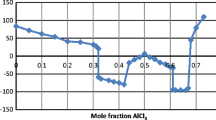Abstract
Ionic liquid salt bridge (ILSB) that effectively minimizes the liquid junction potential in a galvanic cell articulates the nonthermodynamic measurability of single-ion activity. Points for further improvement of the stability of ILSB are summarized, and associated intriguing phenomena at the ILSB-W interface are described.
Similar content being viewed by others
References
Anes B, Silva RJNB, Oliveira C, Camoes MF (2019) Seawater pH measurements with a combination glass electrode and high ionic strength tris-tris hcl reference buffers—an uncertainty evaluation approach. Talanta 193:118–122
Camoes F, Anes B, Martins H, Oliveira C, Fisicaro P, Stoica D, Spitzer P (2016) Assessment of H+ in complex aqueous solutions approaching seawater. J Electroanal Chem 764:88–92
de Levie R (2014) A pH centenary. Electrochim Acta 135:604–639
de Levie R (2017) Electroanalytical obscurity an alternative view. Rev Polarogr 63(2):69–87
Eriksen DK, Lazarou G, Galindo A, Jackson G, Adjiman CS, Haslam AJ (2016) Development of intermolecular potential models for electrolyte solutions using an electrolyte SAFT-VR Mie equation of state. Mol Phys 114(18):2724–2749
Ermantraut A, Radtke V, Gebel N, Himmel D, Koslowski T, Leito I, Krossing I (2018) The ideal ionic liquid salt bridge for direct determination of Gibbs energies of transfer of single ions, part II: evaluation of the role of ion solvation and ion mobilities. Angew Chem-Int Edit 57(9):2348–2352
Fraenkel D (2010) Simplified electrostatic model for the thermodynamic excess potentials of binary strong electrolyte solutions with size-dissimilar ions. Mol Phys 108(11):1435–1466
Fraenkel D (2011) Monoprotic mineral acids analyzed by the smaller-ion shell model of strong electrolyte solutions. J Phys Chem B 115:557–568
Fraenkel D (2015) Computing excess functions of ionic solutions: the smaller-ion shell model versus the primitive model. 1. Activity coefficients. J Chem Theory Comput 11(1):178–192
Fujino Y, Kakiuchi T (2011) Ionic liquid salt bridge based on n-alkyl-n-methylpyrrolidinium bis(pentafluoroethanesulfonyl)amide for low ionic strength aqueous solutions. J Electroanal Chem 651 (1):61–66
Harned HS, Ehlers RW (1932) The dissociation constant of acetic acid from 0 to 35∘ centigrade. J Am Chem Soc 54:1350–1357
Kakiuchi T (2002) Electrochemical instability of liquid|liquid interface in the presence of ionic-surfactant adsorption. J Electroanal Chem 536:63–69
Kakiuchi T (2015) Obscurity in electroanalytical chemistry (english translation). Rev Polarogr 61:105–116
Kakiuchi T (2017) Commenets to “Electroanalytical obscurity: an alternative view” by Robert de Levie. Rev Polarogr 63(2):89–100
Kakiuchi T, Yoshimatsu T (2006) A new salt bridge based on the hydrophobic room-temperature molten salt. Bull Chem Soc Jpn 79(7):1017–1024
Kakiuchi T, Tsujioka N, Kurita S, Iwami Y (2003) Phase-boundary potential across the nonpolarized interface between the room-temperature molten salt and water. Electrochem Commun 5(2):159–164
Kakiuchi T, Shigematsu F, Kasahara T, Nishi N, Yamamoto M (2004) Electrocapillarity at the nonpolarized interface between the aqueous solution and the room-temperature molten salt composed of 1-octyl-3-methylimidazolium bis(pentafluoroethylsulfonyl)imide. Phys Chem Chem Phys 6 (18):4445–4449
Kitazumi Y, Kakiuchi T (2011) Electrochemical instability in liquid-liquid two-phase systems. Bull Chem Soc Jpn 84(12):1312–1320
Kudo Y, Shibata M, Nomura S, Ogawa N (2017) Application of a pH electrode incorporating an ionic liquid salt bridge to the measurement of rainwater samples. Anal Sci 33(6):739–742
Lindner E, Guzinski M, Khan TA, Pendley BD (2019) Reference electrodes with ionic liquid salt bridge: when will these innovative novel reference electrodes gain broad acceptance? ACS Sens 4(3):549–561
Liu JL, Eisenberg B (2015) Poisson-Fermi model of single ion activities in aqueous solutions. Chem Phys Lett 637:1–6
May PM, Rowland D (2017) Thermodynamic modeling of aqueous electrolyte systems: current status. J Chem Eng Data 62(9):2481–2495
McGuigan JAS, Kay JW, Elder HY (2016) Ionised concentrations in calcium and magnesium buffers: standards and precise measurement are mandatory. Prog Biophys Mol Biol 121(3):195–211
Metcalf RC (1987) Accuracy of Ross pH combination electrodes in dilute sulfuric-acid standards. Analyst 112(11):1573–1577
Mousavi MPS, El-Rahman MK, Tan EKW, Sigurslid HH, Arkan N, Lane JS, Whitesides GM, Buhlmann P (2019) Ionic liquid-based reference electrodes for miniaturized ion sensors: what can go wrong? Sens Actuator B-Chem 127112:301
Radtke V, Ermantraut A, Himmel D, Koslowski T, Leito I, Krossing I (2018) The ideal ionic liquid salt bridge for the direct determination of Gibbs energies of transfer of single ions, part I: the concept. Angew Chem-Int Edit 57(9):2344–2347
Sakaida H, Kakiuchi T (2011) Determination of single-ion activities of H+ and Cl− in aqueous hydrochloric acid solutions by use of an ionic liquid salt bridge. J Phys Chem B 115 (45):13222–13226
Sakaida H, Kitazumi Y, Kakiuchi T (2010) Ionic liquid salt bridge based on tributyl(2-methoxyethyl)phosphonium bis(pentafluoroethanesulfonyl)amide for stable liquid junction potentials in highly diluted aqueous electrolyte solutions. Talanta 83(2):663–666
Shibata M, Yamanuki M, Iwamoto Y, Nomura S, Kakiuchi T (2010) Stability of a Ag/AgCl reference electrode equipped with an ionic liquid salt bridge composed of 1-methyl-3-octylimidazolium bis(trifluoromethanesulfonyl)amide in potentiometry of ph standard buffers. Anal Sci 26(11):1203–1206
Volia MF, Tereshatov EE, Boltoeva M, Folden CM (2020) Indium and thallium extraction into betainium bis(trifluoromethylsulfonyl)imide ionic liquid from aqueous hydrochloric acid media. New J Chem 44 (6):2527–2537
Yoshimatsu T, Kakiuchi T (2007) Ionic liquid salt bridge in dilute aqueous solutions. Anal Sci 23(9):1049–1052
Zhang LM, Miyazawa T, Kitazumi Y, Kakiuchi T (2012) Ionic liquid salt bridge with low solubility of water and stable liquid junction potential based on a mixture of a potential-determining salt and a highly hydrophobic ionic liquid. Anal Chem 84(7):3461–3464
Author information
Authors and Affiliations
Corresponding author
Additional information
Publisher’s note
Springer Nature remains neutral with regard to jurisdictional claims in published maps and institutional affiliations.
Rights and permissions
About this article
Cite this article
Kakiuchi, T. Single-ion activity: a nonthermodynamically measurable quantity. J Solid State Electrochem 24, 2093–2095 (2020). https://doi.org/10.1007/s10008-020-04758-0
Received:
Revised:
Accepted:
Published:
Issue Date:
DOI: https://doi.org/10.1007/s10008-020-04758-0




